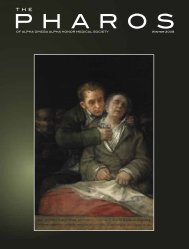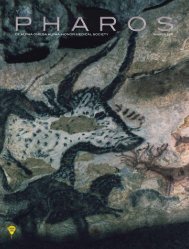4 - Alpha Omega Alpha
4 - Alpha Omega Alpha
4 - Alpha Omega Alpha
You also want an ePaper? Increase the reach of your titles
YUMPU automatically turns print PDFs into web optimized ePapers that Google loves.
David P. Hill<br />
Editorial<br />
Marat and Harvey, revolutionaries<br />
Edward D. Harris, Jr., MD<br />
Revolution is defined in several ways. One is the forcible<br />
overthrow of a government or social order in favor<br />
of a new system. This type of revolution invariably<br />
occurs over a short period of time. “Marat’s Terror” by Jesse<br />
Woodard (pp. 17–24) describes the troubled but powerful life<br />
of physician/ polemicist Jean-Paul Marat and his role in the<br />
French Revolution. His fiery doctrines were quenched suddenly<br />
when Charlotte Corday stabbed him while he bathed.<br />
Revolutions in medicine and the medical sciences<br />
are less radical and follow a second definition: a dramatic<br />
and wide- reaching change in the way something<br />
works or is organized and in people’s ideas<br />
about it, a transition from one paradigm to another.<br />
Today’s physicians and scientists are familiar with<br />
this type of revolution. We have experienced the<br />
discovery of penicillin, streptomycin, and cortisone;<br />
the development of vaccines against poliomyelitis<br />
and other infectious scourges; the definition of the<br />
structure of DNA, the translation of the genetic<br />
code, and the establishment of methods to synthesize<br />
DNA; the initiation and growth of transplant<br />
surgery; the technical advances informing CT, MRI,<br />
microarrays, and stem cell biology; and the slower<br />
but no less important revolutions in public health.<br />
We relish the exploration of the unknown.<br />
Why did it take more than 1500 years, from<br />
the first to the seventeenth century, for empiric<br />
observations to enable understanding of the circulation?<br />
Galen, in the first century AD, adopted the<br />
Hippocratic theory of the four humours: blood, phlegm, and<br />
yellow and black bile, and the importance of having balance<br />
among them to ensure good health. Although reported to be<br />
conceited, cruel, and vindictive, he cannot be blamed for the<br />
blind allegiance to his teachings that persisted for centuries.<br />
Those who followed Galen failed to use the tools they had—<br />
eyes, brain, and hands—for at least two reasons: first, human<br />
dissection was prohibited, and second, it was philosophers<br />
and the clergy who for many centuries determined the truths<br />
of life for the people. Most significant among those who led<br />
thought was Aristotle. Bertrand Russell writes that ”it was two<br />
thousand years before the world produced any philosopher<br />
who could be regarded as approximately his equal.” 1 It was<br />
Aristotle who gave science to mankind. He observed, and<br />
deduced logical conclusions. Consider his realization that<br />
no drop of water has been added to nor taken from the earth<br />
and its atmosphere since creation: “This is a cyclic world, says<br />
our philosopher: the sun forever evaporates the sea, dries up<br />
rivers and springs, and transforms at last the boundless ocean<br />
into the barest rock; while conversely the uplifted moisture,<br />
gathered into clouds, falls and renews the rivers and the seas,”<br />
writes Will Durant. 2 Aristotle observed that life was growing<br />
steadily in complexity and power, with increasingly specialized<br />
function. Indeed, he was on the verge of deducing the theory<br />
of evolution. Why then was Aristotle not the one to define the<br />
physiology of the circulation, that the heart (not the brain)<br />
pumped blood through arteries, and that blood flowed back<br />
to the pump through thinner vessels, the veins? He certainly<br />
had each of the tools—eyes, a brain, and hands—needed to<br />
do this.<br />
William Harvey based his<br />
theory of the circulation of the<br />
blood on a series of simple experiments<br />
in which he studied<br />
venous blood flow using<br />
a tourniquet and digital compression.<br />
His famous book,<br />
“Ecercitatio anatomica de motu<br />
cordis,” published in 1628, illustrates<br />
these experiments and<br />
elucidates the observations he<br />
made and deductive reasoning<br />
he used to arrive at this theory.<br />
Traditionalists following in the<br />
footsteps of Galen attempted<br />
to reject Harvey’s conclusions,<br />
but uniformly failed to find<br />
weaknesses in either his experiments<br />
or deductions because<br />
to deny a single part of<br />
Harvey’s theory would be to reject the whole, and this was<br />
impossible. Nevertheless, many tried!<br />
The revolution sparked by Harvey’s new paradigm brought<br />
much new knowledge from diverse sources. For example,<br />
Antoine van Leeuwenhoek built an instrument, the microscope,<br />
that would be a revolution in itself. Leeuwenhoek’s<br />
microscope revealed the presence of red blood cells and, more<br />
importantly, the hair-thin anastomoses between the blood<br />
vessels that he named “capillaries,” a discovery that linked the<br />
veins and arteries to complete the elements of the circulation<br />
that Harvey had outlined.<br />
Scientific revolutions continue to evolve in both intensity<br />
and sophistication, combining the resources of eyes, brains,<br />
and hands to bring biological science to the heights it has<br />
reached today, with more to be ascended tomorrow.<br />
Courtesy of the National Library of Medicine<br />
References<br />
1. Russell B. History of Western Philosophy. London: George<br />
Allen & Unwin; 1974: 173.<br />
2. Durant W. The story of philosophy. New York: Simon and<br />
Schuster; 1953: 53.<br />
The Pharos/Spring 2009 1














